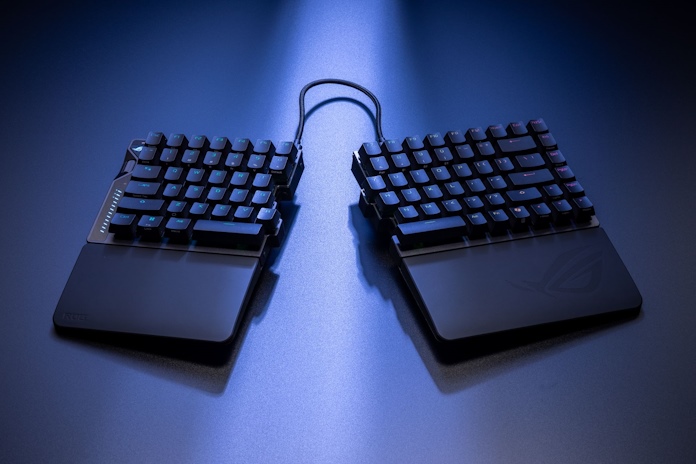My back spasms when I think about the dorm room setup that I used to play Diablo II in college. I’d lean back in a fold-out camping chair with a footrest, my notebook propped up on my lap. Then, I would pull over my flat-backed desk chair and use its seat as both a mousing surface and a coaster for my can of Mountain Dew.
I can’t explain how I avoided long-lasting physical damage after gaming like this for most of a school year, other than to say that I was nineteen, and you can get away with stuff at that age. But it didn’t take all that long for my bad decisions to catch up to me. Even after I moved on from that dorm room and my Diablo II obsession, I started to feel nagging cramps and aches in my wrists and lower back after gaming for a while. My neck would feel stiff, and my eyes felt strained and tired, too.
Piece by piece, I started to upgrade my PC setup, not just for improved performance, but also for increased comfort. Over the years, I’ve assembled a battlestation that limits eye fatigue, keeps my wrists happy, and promotes healthy posture. Here’s what I’ve learned along the way.
Your chair matters more than you might think
I quickly moved on from the fold-out camping chair, but the office chairs that I used in the years that followed weren’t all that special. Mostly, I made do with whatever I could find on the cheap. Even when I finally made my first grown-up purchase of a real office desk chair, I cut too many corners.
But then I started working from home, and that chair became more than just my gaming throne. And that’s when its limited range of ergonomic options started to cause me some real problems. I developed an ache on the outside of my left hip. I thought the problem was my shoes, but the pain didn’t go away even after I replaced my main pair.
The ache cleared up almost immediately after I upgraded my chair. What I looked for was the ability to customize just about everything: seat height, seat depth, lumbar support, armrests, and more. I paid more for these niceties, and that investment paid off within a matter of days.
I acknowledge that I ended up with a very practical-looking chair with no sense of style. I don’t mind being called “basic,” but perhaps you’d prefer something that coordinates with the rest of your gaming setup. Gaming chairs and ergonomic desk chairs used to be separate product categories, but these days it’s possible to get a chair that straddles both worlds. Check out the ROG Destrier Ergo Gaming Chair if you’re interested.
Why standard keyboards can increase your risk for health concerns
With my hip problems resolved, my body had to get creative in its pursuit of making me feel old. It moved on to my wrists and shoulders. Since I’ve already taken the risk of making this article read like a litany of my health complaints, I won’t go into detail here other than to recommend that you be very proactive when it comes to selecting a keyboard and mouse that keep your shoulders, arms, and hands relaxed and comfortable. Odd twinges and aches in any of the joints ranging from your shoulder to the back of your hands are a sign that you probably waited too long to get ergonomic hardware, and you should get on it ASAP.
The trouble with keyboards is that they can force your wrists and arms into awkward positions. When you’re typing, they bend your wrists outward, force your hands flat on your desk, and pull your shoulders inward. None of that is natural or conducive to the long-term health of your joints and tendons. Gamers don’t tend to spend much time with both hands on the keyboard, helping them avoid some of this, but mouse-and-keyboard gaming has its own perils. Having your hands spread out too wide can lead to nagging pain in your shoulders.
Tenkeyless keyboards can reduce shoulder strain, and an ergonomic split keyboard gives you ultimate comfort
Thankfully, you have options for reducing your risk of repetitive strain injuries, and these options won’t cramp your gaming ambitions. Ergonomic keyboards are built to encourage a neutral posture that doesn’t strain your body. Most are designed for office use, but that’s changing as new options designed for gamers are hitting the market. The ROG Falcata is a split gaming keyboard that allows your arms to rest at a natural angle when you’re using the keyboard. Adjustable feet let you “tent” the keyboard by raising up the middle, allowing your palms to face each other more naturally.
The ROG Falcata also helps make sure your hands don’t spread unnecessarily wide while you’re gaming. As a 75% keyboard, it drops the numpad entirely in the name of a space-saving design, opening up extra space for your mousing hand. But you can go a step further and unplug the right half of the board entirely for games that don’t need the whole keyboard.
Other ergonomic keyboards can help you out when it comes to posture, but few pair those health-forward features with a robust suite of tools for gaming. With the ROG Falcata, you’ll have a competitive edge with hot-swappable ROG HFX V2 Magnetic Switch and ROG Hall Sensor for ultra-responsive keystrokes. It includes a Rapid Trigger toggle, ROG SpeedNova 8K wireless technology, Speed Tap mode, and more.
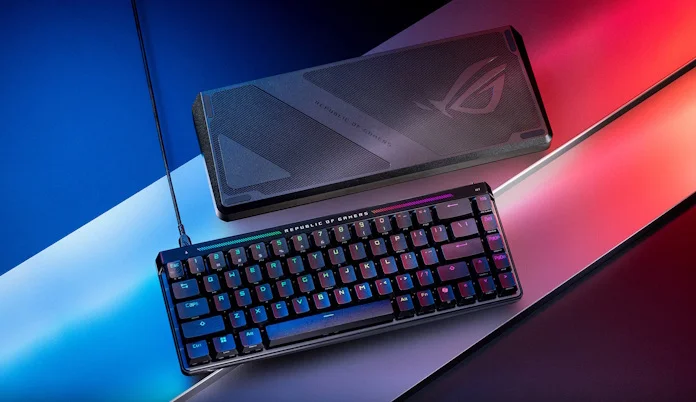
Admittedly, split keyboards come with a learning curve. If you’re used to standard keyboards, you’ll have to spend some time building muscle memory to get comfortable with the new layout. If that’s a concern, or if a split keyboard isn’t feasible for other reasons, you might consider a compact keyboard as an alternative. The ROG Falchion Ace HFX is a 65% gaming keyboard that demands very little desk space, giving you the freedom to arrange your peripherals in the way that’s most comfortable for long gaming sessions. For one, you’ll be able to rotate it for mouse-and-keyboard gaming to keep your shoulder at a natural angle. Like the ROG Falcata, it keeps you on top of the action with ROG HFX Magnetic Switches, Rapid Trigger, and Speed Tap Mode.
Key travel, key travel, key travel
Let’s think about what it’s like for your fingers when you play Counter-Strike 2. Every time you tap a key — or smash it furiously and repeatedly, as happens too often in the heat of battle — your finger exerts a bit of work and absorbs a certain amount of force. If you’re not thoughtful about how you’re pressing each key and what key switches you’re using, you can fatigue your fingers and stress out your joints.
There’s no one-size-fits-all solution for key switches, but broadly I’ve found that mechanical switches are far easier on my fingers than membrane switches, which require me to bottom out the switch with every single press. The latest gaming-focused mechanical switches, like the ROG NX Snow switches, have a light actuation force and a high actuation point, making it less likely that you’ll press one all the way down. Some laptop keyboards are better than others, but if I’m using a laptop at my desk I always hook up a keyboard to take advantage of its longer key travel. Some folks do better with switches that offer tactile feedback at the actuation point, as that little bump helps them avoid pushing each key farther than they need to. But the extra force needed to push each key can fatigue my fingers.
For gaming, I’ve found that the latest magnetic switches have helped me curb some of my worst habits. When I play FPS, MOBAs, and RTS games, I tend to mash the keys way too hard. Rapid Trigger technology, available with boards featuring ROG HFX magnetic switches, gives me a competitive reason to be a little lighter on my feet fingers. Traditional mechanical switches require a return to the reset point before the next keystroke registers. With Rapid Trigger enabled, the switch resets instantly as it moves upward. If I lightly flutter a key without pushing it all the way in, I can very quickly register many keystrokes. That’s an advantage in many scenarios, and it reduces the impact fatigue on my fingers, too.
Weight matters when it comes to your mouse and headset
As a guy, I don’t like to complain about lifting heavy things. There’s a testosterone-addled voice in the back of my mind that tells me to man up and build up some strength. But when it comes to my mouse and headset, I’ve learned to ignore the inclination to turn every activity into a workout. Lighter is better.

It feels weird to complain about some of the heftier mice on the market, which can range upward of 175g, but they wear out my shoulder, and not in the happy-building-muscles kind of way but the what-have-I-done-to-my-tendons way. I’ll especially feel it if I’m playing Counter-Strike 2, which calls for big sweeping mouse movements. My current favorite is the ROG Keris II Origin, an ultra-precise 65g clicker. It’s one of the lightest mice out there that still feels sturdy under my hands — and offers a push-fit switch socket design which allows me to easily replace worn-out switches. If you want to go even lighter, check out the ROG Harpe Ace Extreme, which uses a carbon fiber shell to drop all the way down to 47 grams.
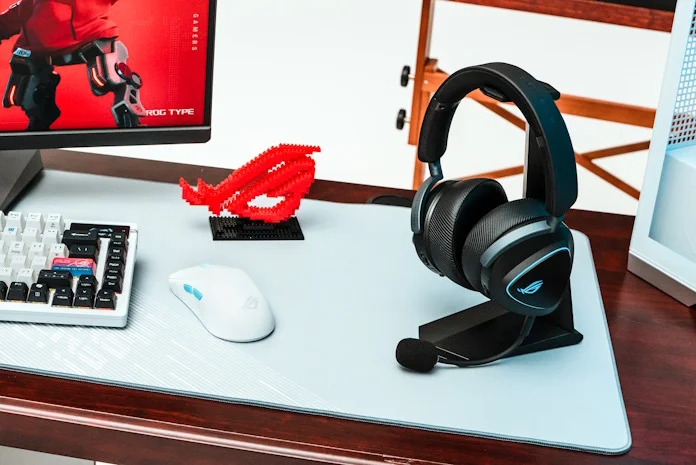
The same thing goes with headsets. After an hour or two of gaming with a heavy headset, my neck gets sore. My preference is always to find a lightweight pair that doesn’t skimp on sturdy construction. Etail sites are full of cheap knockoffs that are certainly lightweight, but only because they’re built of cheap plastic that’s not built to last.
Wide-ranging ergonomic adjustments are a must-have for your display, but a display arm is even better
Poor display setups are a common culprit when it comes to neck pain and fatigue. If your display is raised up too high, you’ll crane your neck too much. If it’s too low — like when your laptop is on your desk, but not raised up on a stand — you’ll hunch forward too much. Ideally, you should place the top of your screen at or just below eye level, allowing your eyes to gaze slightly downward at the center of the screen. Tilt it back slightly as necessary to keep the viewing surface perpendicular to your line of sight to minimize glare and keep your head at a comfortable angle.
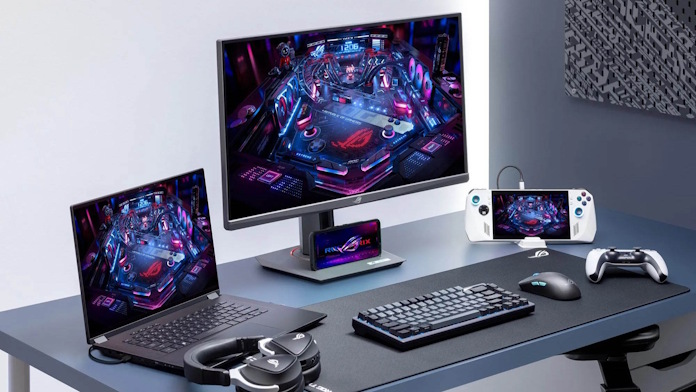
A monitor that’s cutting too many corners to save on cost usually skimps on ergonomic adjustments. But you won’t need a top-shelf display to get a full suite of options. Monitors in the ROG XG series won’t break the bank, and models like the ROG Strix XG27ACS give you generous tilt, swivel, pivot, and height adjustments.
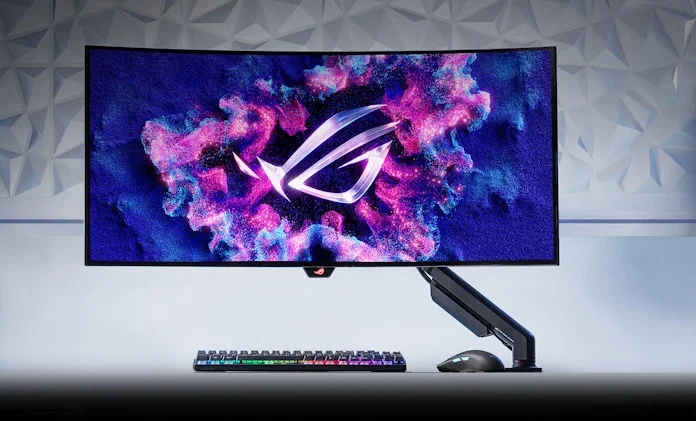
They also give you VESA wall mount capability, which I highly recommend. Many desktop setups don’t give you a lot of leeway for deciding how far away from your eyes you want to have your monitor. A monitor mount will give you much more control over how your display is positioned while freeing up space that would have been given over to the monitor stand. Grab the ROG Ergo Monitor Arm and you’ll have cable management channels and gamer style in a durable, battle-proven design.
Get a monitor with great color performance and contrast at any brightness level
As a guy who works from home and likes to play PC games, I have a lot to say about eye strain. For too long, I kept a bottle of eye drops in my desk drawer because I didn’t realize just how much my display setup was fatiguing my eyes. A few important changes made a big impact.
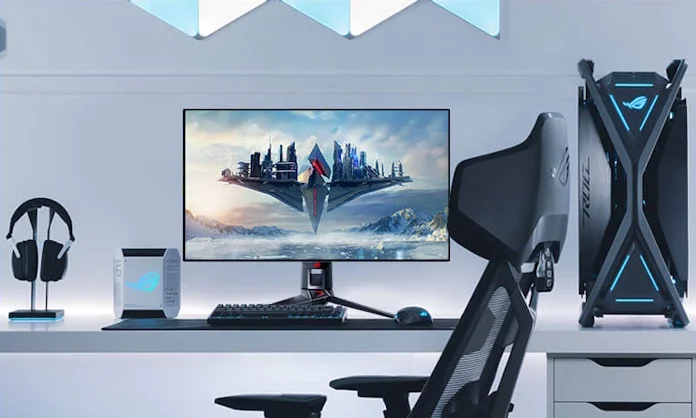
One adjustment that made a big difference for me was getting a larger monitor and placing it farther away from my eyes. The trick is to find a distance that’s close enough so that you don’t have to squint to read text, but far enough away that its brightness doesn’t fatigue your eyes. I’m happy to go very big with my PC monitor in order to be able to sit back from it — a 32-inch display isn’t too big, in my experience, especially if it’s on a monitor mount that lets me position it perfectly.
Second, I’ve learned to be pickier about a monitor’s color performance at low brightness levels than its max brightness level. Yes, I do like the ability to crank up the brightness to combat the high ambient lighting in my home office when the morning sunlight is streaming in. But also I have curtains. What’s more important to me is the ability to crank down the brightness very low when I’m gaming in the late evening without sacrificing image quality. Older display technologies lose a lot of contrast and color vibrancy at low brightness levels, inclining me to set their brightness level too high for comfort. Next-gen OLED panels perform much better in this regard. Even when I set the brightness very low for comfortable viewing in a dark room, the image isn’t washed out, allowing me to game for longer without tapping out due to eye strain.
Third, dark mode for Windows and various apps has been an absolute godsend. Looking back, I can’t believe how much time I spent at a PC with a full-white background of office documents searing my retinas.
Schedule time away from your desk
One final suggestion for comfortable long-term PC use, and it’s easily the most important. Step away from your computer sometimes. Quite regularly, if at all possible. Your body wasn’t designed to sit in a chair all day, even the most ergonomic model on the market, and your eyes weren’t built to stare endlessly at a bright object two feet away, either. If you want to maintain your gaming hobby into your adult life, you have to take care of yourself.
As a teenager or a college student, you can get away with a sub-optimal setup. Past that point, you need to be thoughtful and deliberate about your PC setup and how you’re using it. With the right chair, peripherals, and display, you can do a lot to minimize fatigue and strain. But stepping away from your desk every hour or so will do a lot more.

